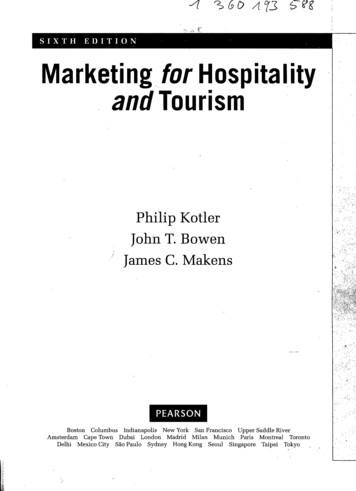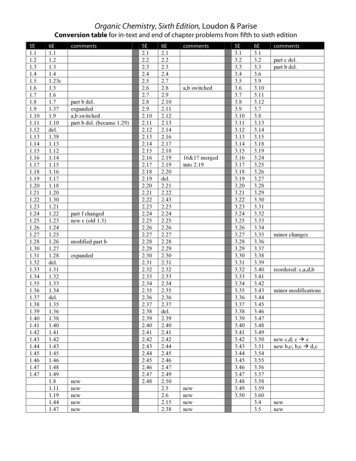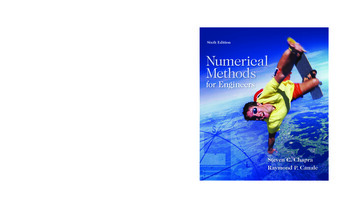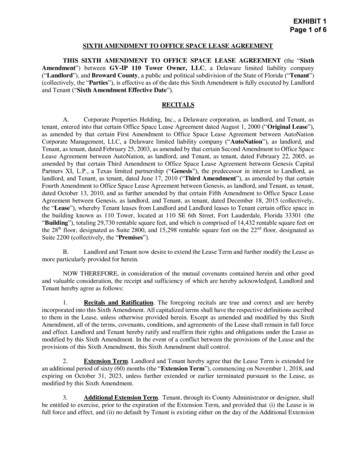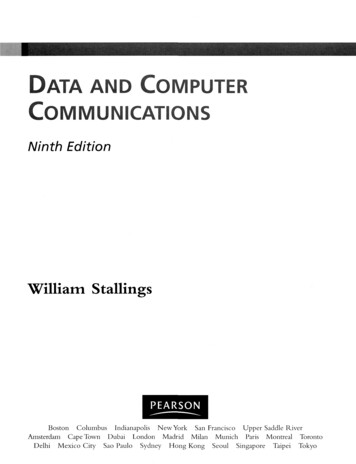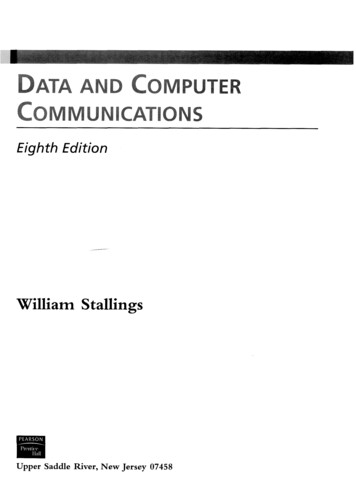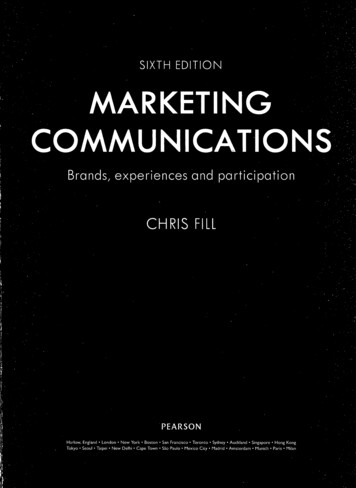
Transcription
SIXTH EDITIONMARKETINGCOMMUNICATIONSBrands, experiences and participationCHRIS FILLPEARSONHarlow, England * London New York Boston San Francisco Toronto Sydney Tokyo Seoul Taipei New Delhi Cape Town * Sao Paulo Mexico City * Madrid
ContentsGuided tourForewordPrefaceAcknowledgementsPublisher's acknowledgementsXXIVxxviixxixxxxixxlPart 1 Introduction to marketingconnmunications1Introducing marketing communicationsAims and learning objectivesMinicase: LV a spectacular revivalIntroductionThe concept of marketing as an exchangeMarketing communications and the process of exchange"The scope of marketing communicationsThe role of marketing communicationsThe tasks of marketing communicationsDefining marketing communicationsEnvironmental influencesInternal influencesMarket influencesExternal influencesThe marketing communication mixAdvertisingSales promotionPersonal sellingPublic relationsDirect marketingThe key characteristics of the communication toolsMedia and the MCs mixKey differences between conventional and digital mediaMessages and the MCs mixCriteria when selecting the tools for the mixControlFinancial resourcesCredibilityDispersion - size and geographyCommunication 31323232
Xi CONTENTS2Communication differencesMessage reception Number of decision-makersThe balance of the communications mixThe constituent tools of the marketing communications mixMessage contentMessage originLength of purchase decision time'Negative communicationsTarget marketing and researchBudget allocationMeasurement and evaluation323333333434353535353535Key pointsReview questionsReferences363738Communication: forms and conversations40Aims and learning objectivesMinicase: 'Up your Viva'An introduction to the process of communicationA linear model of rFeedback/responseNoiseRealms of understandingFactors that influence the communication processThe influence of the mediaThe influence of peopleThe influencer model of communicationInteractional model of communicationWord-of-mouth communicationDefinition and motivesOpinion leadersOpinion formersOpinion followersDeveloping brands with word-of-mouth communicationRelational approaches to communicationsNetwork approaches to communicationsProcess of adoptionProcess of 861636365Key pointsReview questionsReferences3(''/*676868Audiences: how they process information and behave71Aims and learning objectivesMinicase: Recruiting teachers - nudging the journeyIntroduction717273
CONTENTSInformation processingPerception Marketing and perceptionLearningCognitive learningCognitive responseAttitudesDecision-makingConsumer purchase decision-making processOrganisational decision-making processPerceived riskInvolvement theoryTwo approaches to decision-makingImpact on communicationsAlternative approachesHedonic consumptionTribal consumptionBehavioural economics,.Key pointsReview 105References4Xi 105How marketing communications might work108Aims and learning objectivesMinicase: Rolex: a range of quality communicationsIntroduction108109111The strategic context111Engagement and the role of marketing communicationsHow does marketing communications work?Interpretation 1 - Sequential modelsInterpretation 2 - Changing attitudes with marketing communicationsUsing marketing communication to influence attitudesInterpretation 3 - Shaping relationshipsInfluencing value exchangesInterpretation 4 - Developing significant valueInterpretation 5 - Cognitive processing111113114116118121125130132ConclusionKey pointsReview questionsReferencesfPart 2 Managing marketing communications135135136- 137139Marketing communications: strategies and planning141Aims and learning objectivesMinicase: Cravendale - milk mattersIntroductionUnderstanding strategy141142144144
XiiCONTENTSMarketing communications strategyStrategy approach 1 - PositioningStrategy approach 2 - AudienceStrategy approach 3 - PlatformStrategy approach 4 - ConfigurationPlanning marketing communicationsThe marketing communications planning frameworkElements of the planContext analysisCommunication objectivesMarketing communication strategyCoordinated communication mixResourcesScheduling and implementationEvaluation and controlFeedbackLinks and essential pointsKey pointsReview 167167168168168168168 170170171.Marketing communications: objectives and positioning173Aims and learning objectivesMinicase: Juan Valdez - the face of Colombian CoffeeIntroductionThe role of objectives in corporate strategyThe role of brand communication objectives and plansThe sales school'The communications schoolDerivation of campaign objectivesSetting realistic marketing communication objectivesThe practitioners' viewBusiness objectivesBehavioural objectivesIntermediate objectivesSMART objectivesPositioningThe development of the positioning conceptThe positioning conceptManaging positionsPerceptual mappingPositioning strategiesProduct features'Price/qualityUseProduct class dissociationUserCompetitorBenefitHeritage or cultural symbolRepositioning173174176176 6196197197197197198198199'
CONTENTS '' Xiii ' 789Key pointsReview questionsReferences199201201The communication industry: structure, operations and issues203Aims and learning objectivesMinicase: Diageo - reaching underage drinkersIntroductionDimensions of the UK marketing communications industryStructure and development of the marketing communications industryAgency types and structuresIndustry structureA short history of one-stop shoppingSelecting an agencyAgency operationsRelationshipsClient/agency relationshipsAgency remunerationAgency structures and IMC203204206208209209213213215218220220222224Key pointsReview questionsReferences229229230Financial resources for marketing communications232Aims and learning objectivesMinicase: HondaIntroductionTrends in communication expenditureThe role of the communication budgetBenefits of budgetingDifficulties associated with budgeting for communicationsTechniques and approachesMarginal analysis: the advertising response functionPractical approachesQuantitative approachesCompetitive parityAdvertising-to-sales ratioShare of voiceStrategic implications of-the SOV conceptAppropriation brand typesThe value of brand communicationsWhich methods are most used?Budgeting for the other elements of the communication 1251253255*-Key pointsReview questionsReferences257258259Evaluation and metrics260Aims and learning objectivesMinicase: Still killing Jill?Introduction260261263
XivCONTENTSThe role of evaluation in planned communicationsAdvertisingPre-testingPre-testing unfinished advertisementsFocus groupsConsumer juriesPre-testing finished advertisementsDummy vehiclesReadability testsProjective techniquesTheatre testsPhysiological measuresPost-testingInquiry testsRecall testsRecognition testsSales testsOther testsTracking studiesFinancial 272275276277277278Likeability10278Public relationsCorporate imageRecruitmentCrisis managementOther PR measuring techniquesMeasuring the fulfilment of brand promisesOnline communicationsSocial media/279280281281282282283285Key pointsReview questionsReferences286288288Integrated marketing communications290Aims and learning objectivesMinicase: Authentic Caribbean rumIntroductionThe development of IMCReasons for the developing interest in IMCWhat is to be integrated?Communication toolsMessagesMarketing finitions of IMCInterpretations of IMCInterpretation 1: Harmonisation-based IMCInterpretation 2: Planning-based IMC290291294294295299299 300300300301301301302304305306306,'
CONTENTS XV ;Interpretation 3: Perspective-based IMCInterpretation 4: Portfolio-based IMCInterpretation 5: Relational-based IMCStructuring for IMC.309313315317Key pointsReview questionsReferences318318319Part 3 Branding32111Brand communications323Aims and learning objectivesMinicase: The Domino Effect - honesty's the best policyIntroductionBrand characteristicsBenefits of brandingBrand portfolios: architecture and formsBrand architectureBrand formsThe strategic role of brandingIntegrationDifferentiationAdded valueThe task of marketing communications in brandingAssociations and personalitiesBrand ineAround-the-lineBusiness-to-business brandingOnline brandingVirtual brand communitiesBrand 1341343343344,346347348349Key pointsReview questionsReferences12'.350352352Corporate branding and communication355Aims and learning objectivesMinicase: The BBC's 'Sachsgate'IntroductionCorporate identity or corporate branding?The building blocks of corporate reputationCorporate personalityCorporate identityCorporate imageDimensions of corporate image355356358359361361364364365
XViCONTENTS13Corporate reputationMind the gaps'Corporate communicationCorporate communication mixSymbolic communicationManagement communicationsMarketing communicationsOrganisational communications.Behavioural communicationsA framework for managing corporate brands366367369371371374375375376376Key pointsReview questionsReferences379380380Employee branding383Aims and learning objectivesMinicase: Torbay CouncilIntroductionMember/non-member boundariesInternal communicationOrganisational identityOrganisational cultureLevels of organisational cultureCulture and communicationBrand engagementIntellectual and emotional aspectsAdvertising and the impact on employeesStrategic credibility.Strategic capabilityPast performanceCorporate communicationsThe credibility of the CEOInternal communications: auditing and planningProcedures associated with a communications auditFunctional capabilityFinancial capabilityManufacturing capabilityMarketing 00401401401403405406406406406Key pointsReview questionsReferences.Part 4 The marketing communication mix14'f407408"408411Advertising: role, forms and strategy413Aims and learning objectivesMinicase: Apple - Think different'IntroductionThe role of advertisingDefining advertising413414416416418
CONTENTS1516XVHSelling propositionsThe use of emotion in advertisingTypes of advertisingAdvertising models and conceptsThe elaboration likelihood modelEclectic models of advertisingThe strong and the weak theories of advertisingUsing advertising strategicallyThe FCB matrixThe Rossiter-Percy gridConsumer-generated advertising419420421423423426428431431431435Key pointsReview questionsReferences437438439Public relations441Aims and learning objectivesMinicase: BP - crisis responseIntroductionCharacteristics of public relationsMedia catchingWhich publics?A framework of public relationsThe press agency/publicity modelThe public information modelThe two-way asymmetric modelThe two-way symmetric modelPublic relations and relationship managementObjectives and public relationsCause-related marketingPublic relations: methods and techniquesMedia relationsPress releasesPress conferencesInterviewsPublicity and eventsLobbyingCorporate advertisingReasons for the use of corporate advertisingInvestor relationsDefensive or crisis communicationsCrisis phasesFraming for crisis communicationIntegrating public relations in the communications 6456456456456458459460462464466468471.-(,'Key pointsReview questionsReferences471472473Sponsorship475Aims and learning objectivesMinicase: The London OlympicsIntroduction475476478.
xviii : CONTENTS17The growth and development of sponsorshipSponsorship objectivesHow sponsorship might workTheoretical aspects of sponsorshipTypes of sponsorshipSports sponsorshipProgramme sponsorshipArts sponsorshipOther forms of sponsorshipThe role of sponsorship in the communication mix480482484485486487487488490493Key pointsReview questionsReferences495496497Direct marketing and personal selling499Aims and learning objectivesMinicase: Office for National Statistics - The 2011 CensusIntroductionThe role of direct marketingTypes of direct brandType 1: complemetary toolType 2: primary differentiatorType 3: sales channelType 4: brand vehicleThe growth of direct marketingGrowth driver 1: technologyGrowth driver 2: changing market contextGrowth driver 3: changing organisational expectationsThe role of the databasePermission marketingDirect response mediaDirect Radio and televisionThe Internet and digital media-.Personal sellingThe tasks of personal sellingThe role of personal sellingStrengths and weaknesses of personal sellingStrengths WeaknessesWhen personal selling should be a major part of the communications mixComplexityBuyer significanceCommunication effectivenessChannel network factorsIntegration and supporting the sales force,Strategic account 521521521522522522523f
CONTENTS1819XixKey account managementKey account managersKey account relationship cyclesSome final aspects of KAMGlobal account management523526527529529Key pointsReview questionsReferences530531532Sales promotion, field marketing and brand experiences534Aims and learning objectivesMinicase: Orange at the Glastonbury FestivalIntroductionUnderstanding the value of sales promotionsThe role of sales promotionShort termismManagerial accountabilityBrand performanceBrand expansionCompetition for shelf spaceSales promotion plans: the objectivesAn overview of how sales promotions workRetention programmesSales promotions: methods and techniquesOther sales promotion devicesField marketingRange of FM activitiesBrand experience and 4555556559"Key pointsReview questionsReferences562563563Brand placement, exhibitions, packaging and licensing566Aims and learning objectivesMinicase: Beyonce - how brand licensing influences popular music actsIntroductionBrand placement/Characteristics of brand placementPlacement issuesTrade shows and exhibitionsReasons to use exhibitionsCharacteristics of exhibitions and trade fairsStrengths 'WeaknessesExhibitions as a form of marketing communicationsDigital media and trade showsMarketing management of exhibitionsHospitality and eventsProduct eventsCorporate eventsCommunity 1581582582
XX' CONTENTSPackagingThe communication dimensions of packagingLicensing20,Key pointsReview questionsReferences589590591Traditional media594Aims and learning objectivesMinicase: Smoke-free South West - 'Wise-up to Roll-ups'IntroductionMedia classification by formMedia classification by sourceEvaluative criteria.CostsCommunication richnessInteractive propertiesAudience profilePrint mediaNewspapersMagazinesBroadcast mediaTelevisionRadioOutdoor mediaBillboards and street furnitureTransitIn-store media.Point-of-purchase (POP) 'Retail media centresCinemaAmbient mediaGuerilla tacticsDirect response 607608609610612612613614616616616Key pointsReview questionsReferences21583583586.?617618618Digital media620Aims and learning objectivesMinicase: HiscoxIntroductionKey forms of digital mediaThe InternetDatabase technologiesMultimediaMobile technologiesBusiness applicationsInteractive televisionVideo 0631
CONTENTSWhat digital media enable users to doInteractivityMultichannel anced relationshipsWebsitesStrengthsWeaknessesWebsite designWebsites - visitor behaviourKey differences between traditional and digital mediaConvergence in marketing 40644646647Key points648Review questionsReferences649650Social, search and interactivity652Aims and learning objectivesMinicase: Inspired by IcelandIntroductionSocial mediaSocial networksViral marketingWeb logsMicrobloggingPodcastingRSSInteractive online communitiesSearch engine marketingSearch engine optimisationPay-per-click searchesEmail marketingShort message services (SMS)AppsWidgetsAffiliate marketingAugmented reality23'XXII652653655655658660661662664664665667 668669670671671673673674Key pointsReview questions675676References676Multichannel campaigns: media and tools679Aims and learning objectivesMinicase: The Salvation ArmyIntroductionInteractivityMultichannel marketingCategorising customers., 679680683683684685
xxii : CONTENTSOnline advertisingBanner ads"Pop-upsMicrositesRich media adsOnline videoOnline gaming'Online sales promotionsOnline public relationsOnline personal sellingOnline direct marketingMultichannel y pointsReview questionsReferences704706706Media planning: delivering the message709Aims and learning objectivesMinicase: Which?IntroductionMedia planning and the media mix.Media switching behaviourInfluential factors for media selectionSwitching behaviourVehicle selectionMedia planning conceptsReach and coverageFrequency.Gross rating pointEffective frequencyRecency planningMedia usage and attitudesEfficiencyPlanning, placing and measuring ads onlineMedia source effects Vehicle atmosphereTechnical and reproduction characteristics of a vehicleAudience/product 19719719720722723724726728730730731733733"fKey pointsReview questionsReferences736737737j25CreativityAims and learning objectivesMinicase: Johnnie Walker - 'Keep Walking'IntroductionWhat is creativity?Creativity and attentionThe importance of contextCreativity as a signal739':739740742742743745747
CONTENTS26XXiii 'The creative processThe creative codeMessage framingStorytellingUser-generated content (UGC)Sourcing content747748750752755757Key pointsReview questionsReferences758759760Messages and appeals763Aims and learning objectivesMinicase: Lynx Jet - fantasy appealsIntroductionMessage sourceEstablishing credibilityCredibility established by the initiatorCredibility established by a spokespersonSleeper effectsStructural elements in a messageMessage balanceConclusion drawingOne- and two-sided messagesOrder of presentationMessage appealInformation-based appealsEmotions- and feelings-based appealsCopycat messagingAdvertising tacticsInformational motivesTransformational 73775781781781782"Key pointsReview questionsReferences786787787Author indexSubject indexf/ Companion WebsiteFor open-access student resources specifically writtento complement this textbook and support your learning,please visit www.pearsoned.co.uk/fillLecturer ResourcesFor password-protected online resources tailored to supportthe use of this textbook in teaching, please visitwww.pearsoned.co.uk/fill790801
Internal communications: auditing and planning 403 Procedures associated with a communications audit 405 Functional capability 406 Financial capability 406 Manufacturing capability 406 Marketing capability f 406 Key points . 407 Review questions 408 References "408 Part 4 The marketing communication mix 411 14 Advertising: role, forms and .
